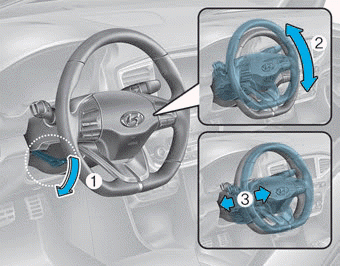Hyundai Ioniq: Tire Pressure Monitoring System / TPMS Receiver. Description and operation
TPMS Receiver : BCM(body control module) integrated management

| 1. | Mode | (1) | Virgin State | –
| The receiver as a sole part is shipped in this state. Replacement parts should therefore arrive in this state. |
| –
| In this state, there is no Auto-Location, no sensor wake-up, no sensor monitoring and no DTC monitoring. |
| –
| The state indicates that platform specific parameters must be written to the receiver and that sensors are un-learned. |
|
| (2) | Normal State | –
| In order for tire inflation state and DTC monitoring to occur, the receiver must be in this state. |
| –
| In this state, automatic sensor location / learning is enabled. |
|
|
| 2. | Overview | –
| Learn TPMS sensor for under inflation monitoring automatically. |
| –
| Uses sensor information, distance travelled, background noise levels, Auto-learn status, short / open circuit output status, vehicle battery level, internal receiver states to determine if there is a system or a vehicle fault. |
|
| 1. | General Function | –
| Auto-learn takes place only once per Ignition cycle. |
| –
| On successful completion, 4 road wheel sensor ID's are latched into memory for monitoring. |
| –
| Until Auto-learn completes, previously learned sensors are monitored for under inflation / leak warnings. |
|
| 2. | General Conditions to Learn New Sensors : | –
| Receiver must determine that it is confident that sensor is not temporary : a. Uses vehicle speed. b. Uses confidence reduction of previously learned sensors. |
| –
| Typical time at driving continuously over 15.5 mph(25 kph) to learn a new sensor is up to 20 minutes. |
|
| 3. | General Conditions to Un-Learn a sensor that is removed : | –
| It takes less than 20 minutes at 15.5 mph(20 - 30 kph). |
| –
| Confidence reduction is dependent on time which vehicle is driven at speed greater than or equal to 12.4 mph (20 - 30 kph). |
|
Replacement1.Remove the valve core and deflate the tire.2.Push the tire as illustration below by using tive change machine.3.Loosen the nut and then remove the TPMS sensor...
Removal1.Disconnect the negative (-) battery terminal.2.Remove the glove box.(Refer to Body - "Glove Box Upper Cover Assembly")3.Remove the smart key unit...
Other information:
Before Entering the Vehicle
Be sure all windows, outside mirror( s), and outside lights are clean and
unobstructed.
Remove frost, snow, or ice.
Visually check the tires for uneven wear and damage.
Check under the vehicle for any sign of leaks.
Be sure there are no obstacles behind you if you intend to back up...
Inspection1.Turn the ignition switch OFF.2.Disconnect the HO2S connector.3.Measure resistance between the HO2S terminals 2 and 5 [B1/S1].4.Measure resistance between the HO2S terminals 3 and 4 [B1/S2].5.Check that the resistance is within the specification...
Categories
Adjust the steering wheel so it points toward your chest, not toward your face.
Make sure you can see the instrument cluster warning lights and gauges. After adjusting,
push the steering wheel both up and down to be certain it is locked in position.
Always adjust the position of the steering wheel before driving.
WARNING
NEVER adjust the steering wheel while driving. This may cause loss of vehicle
control resulting in an accident.

read more

 TPMS Sensor. Repair procedures
TPMS Sensor. Repair procedures TPMS Receiver. Repair procedures
TPMS Receiver. Repair procedures
